归化与异化(英语)
大学英语-翻译课件-归化与异化

especially the Middle East question and the continuation of the cruel war in Viet-Nam. 我们都十分关切当前的重大问题,特别是中东问题和仍在进行的残 酷的越南战争。
×当我们上到山顶时,云升上去了,海港在半圆形的小山中和半明半暗中, 看起来最美。苍白珍珠灰的颜色和仙境般的特征,是非常难以形容和描绘 的。空气是清新和爽快的。北极地区的风景有一种美丽,那与传统圣诞节 卡片适成对照。它们柔和而动人得象照相铜版,没有什么易碎的或太花哨 的东西。
第一种译法不拘泥于原文形式,处理得比较灵活。它根据上下文的意思加 了一些字,把句子联结得十分自然,如在翻译时加了“雾散”,成为“云 消雾散”。在第二句话的前面加了“这一带充满着”。这些意思符合原文 精神实质,这种加法是容许的。第二种译法太机械了,一字对一字,不敢 越出原文一步。根本原因在于对原文食而不化,没有完全吃透。
春,甘美之春,一年之中的尧舜。——郭 沫若
原诗中的king是一般性说法,没有任何特殊 的文化色彩,可是一旦变成了中国古代和 平盛世代名词“尧舜”,就染上了强烈的 汉民族色彩。
评述:归化vs.异化?
Curiosity enough, he prophesied with oracular accuracy to the amazement of all.
sometimes, but his feet always on the ground. [字面意义]一个好老师的头有时要放在云层中,但他的脚
应该永远站在地上。 [意译]好老师有时应该富于幻想,但时时刻刻必须从实际
中英互译中的异化法与归化法

中英互译中的异化法与归化法一、异化与归化的含义异化:指在翻译方法上迁就外来文化的特点吸纳外语表达方式。
Foreignization: refers to the characteristics of foreign cultures before the translation method, and absorbs foreign language expressions .归化:指恪守本族文化的语言传统,回归地道的本族语表达方式。
Domestication: the language tradition that abides by the native culture and the idiomatic expression of native language .二、翻译实例:1、A good teacher should have his head in the clouds sometimes , but his feet always on the ground .异化法翻译:一个好老师的头有时要放在云层中,但他的脚应该永远站在地上。
归化法翻译:一个好老师应该有时富于幻想,但时刻必须从实际出发。
2、Go to law for sheep , you lose a cow .异化法翻译:为了一只羊打官司,却损失了一头牛。
归化法翻译:捡了芝麻,丢了西瓜。
异化法: trump card王牌sour grapes酸葡萄grade inflation分数贬值归化法:talk horse吹牛at a stone’s throw近在咫尺,一箭之遥wet like a drown湿如落汤鸡as stupid as a goose蠢得像猪A big reward will make the brave come forward. 重赏之下,必有勇夫。
Only a headhunter like Bo Le---an ancient Chinese good at headhunting fine steeds---can discover talented people. 有伯乐而后得千里马。
归化异化英文
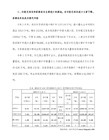
Hawkes’ version: Even the cleverest housewife can't cook bread without flour.
However, that is not to say that the Yangs will always keep to a foreignizating translation or Hawkes’ will stick to strict domestication all the time. In fact, they take diferent methods according to their needs and purposes.
关于归化与异化的理解
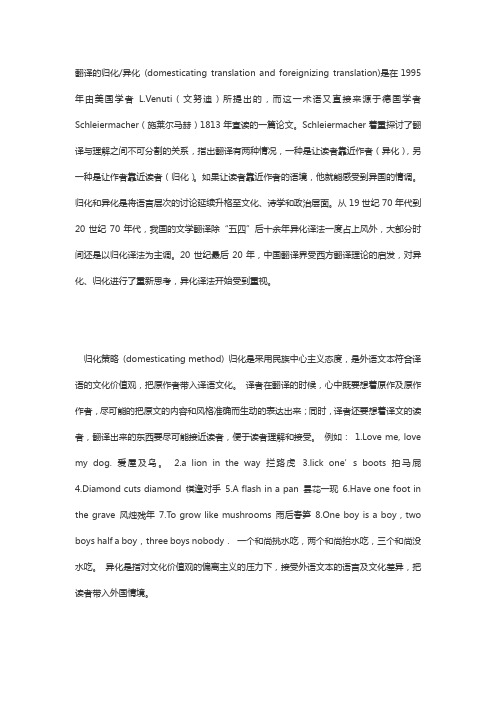
翻译的归化/异化(domesticating translation and foreignizing translation)是在1995年由美国学者L.Venuti(文努迪)所提出的,而这一术语又直接来源于德国学者Schleiermacher(施莱尔马赫)1813年宣读的一篇论文。
Schleiermacher着重探讨了翻译与理解之间不可分割的关系,指出翻译有两种情况,一种是让读者靠近作者(异化),另一种是让作者靠近读者(归化)。
如果让读者靠近作者的语境,他就能感受到异国的情调。
归化和异化是将语言层次的讨论延续升格至文化、诗学和政治层面。
从19世纪70年代到20世纪70年代,我国的文学翻译除“五四”后十余年异化译法一度占上风外,大部分时间还是以归化译法为主调。
20世纪最后20年,中国翻译界受西方翻译理论的启发,对异化、归化进行了重新思考,异化译法开始受到重视。
归化策略(domesticating method) 归化是采用民族中心主义态度,是外语文本符合译语的文化价值观,把原作者带入译语文化。
译者在翻译的时候,心中既要想着原作及原作作者,尽可能的把原文的内容和风格准确而生动的表达出来;同时,译者还要想着译文的读者,翻译出来的东西要尽可能接近读者,便于读者理解和接受。
例如:1.Love me, love my dog. 爱屋及乌。
2.a lion in the way 拦路虎3.lick one’s bo ots 拍马屁4.Diamond cuts diamond 棋逢对手5.A flash in a pan 昙花一现6.Have one foot in the grave 风烛残年7.T o grow like mushrooms 雨后春笋8.One boy is a boy,two boys half a boy,three boys nobody.一个和尚挑水吃,两个和尚抬水吃,三个和尚没水吃。
专题讲座1 归化与异化:习语的英译
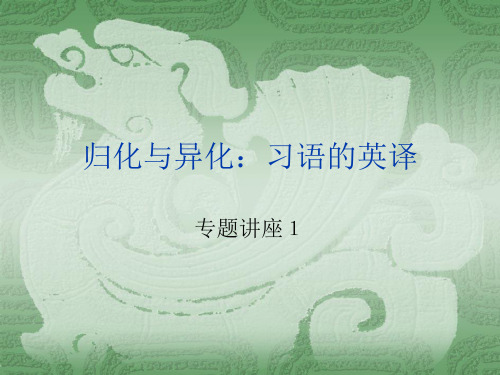
挥金如土 to spend money like water 烂醉如泥 drunk as a sailor 热锅上的蚂蚁 like a cat on a hot tin roof 瘦得像猴子 as thin as a shadow 如履薄冰 to tread upon eggs 棋逢敌手 diamond cut diamond 挂羊头卖狗肉 cry up wine and sell vinegar
初出茅庐 at the beginning of one’s career 罄竹难书 (of crime) too numerous to mention 失之东隅 收之桑榆 What one loses on the swings, one gets back on the roundabouts. 塞翁失马 安知非福?A loss may turn out to be a gain. 庆父不除 鲁难未已 There will always be trouble until the trouble-maker is removed.
虽然有时似乎受伤,其实并不,至多不过是 假装跛腿,聊以引起人们的恻隐之心,可以 从容避匿罢了。 Sometimes it may look hurt, but this is put on: it pretends to limp to enlist sympathy, so that it fan go into hiding comfortably.
他一家子在这儿,他的房子、地在这儿,他 跑?跑得了和尚跑不了庙。(周立波:《暴 风骤雨》) Escape? But his home and property can’t escape. The monk may run away, but the temple can’t run with him. 咳!这一来,竹篮子打水一场空了。(梁斌: 《红旗谱》) Ah!We were drawing water in a bamboo basket.
第二节 归化与异化
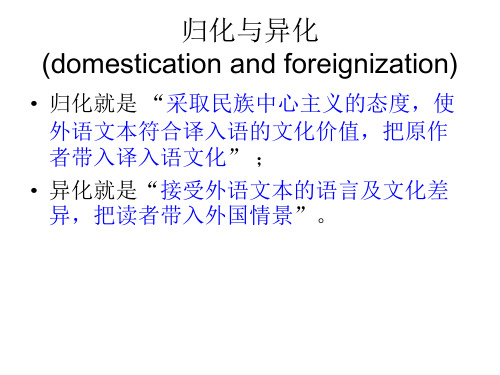
• Conclude : 异化为主,归化为辅。 • High buildings and large mansions are springing up like mushrooms in Beijing. • 在北京,高楼大厦犹如雨后春笋般地涌现。 • They said a sharp no to our proposals. • 他们断然拒绝了我们的建议。 • “I know Dad,” she said, “I’m a selfish Pig. I’ll think about it…” • “我知道,爸,”她说,“我是个自私鬼。 我会考虑这个问题的。”
• • • • • • •
冰冻三尺,非一日之寒。Rome was not build in a day. (罗马不是一日建成的。) 猫哭老鼠to shed crocodile tears(掉鳄鱼眼泪) 笑掉大牙to laugh off one’s head (笑掉脑袋) 沧海一粟to drop in the ocean(沧海一滴水) 画蛇添足to paint / gild the lily(给百合花上色) 异化译法不仅仅是直译的结果,更是一种文化传播, 东方读者对西方的文化的理解也上升到了一个新 的层面。
• • • • • •
骑虎难下 欲加之罪,何患无辞? 量小易怒 失之东隅,收之桑榆 狗头、狗脖子 瓜子脸
Exercises
• 1. Bill’s new girlfriend is certainly a knockout. • 2. Our team won the game, all right, but it was touch and go for a while. • 3. He was smooth and agreeable. • 4. We are one nation, one people. • 5. What is known is that weight extremes in either direction are definitely unhealthy. • 6. He acts a lot older than his years. • 7. His best jokes fell flat.
归化与异化

Domestication & Foreignization归化与异化一、异化归化的概念及特点Questions:长期以来,翻译中一直存在着源语(source language)与目的语(target language),原文作者与目的语读者之间的矛盾。
如何解决这些矛盾呢?怎样尊重及保存民族文化?怎样将有中国特色的文化传统译介给国外的读者?如何在翻译中保持源语的文化特征?1.归化与异化的正式提出:1995年,美国翻译理论家劳伦斯韦努蒂(Lawrence Venuti)的《译者的隐身:一部翻译史》(The Translator’s Invisibility: A History of Translation)问世,里面使用了一对关键术语—domesticating translation & foreignizing translation, 中文译作“归化”和“异化”。
归化(Domestication):“the translation strategy in which a transparent, fluent style is adopted in order to minimize the strangeness of the foreign text for TL (target language) readers”.是指在翻译中采用透明、流畅的风格,最大限度地淡化原文的陌生感的翻译策略。
归化尽可能的使源语文本所反映的世界接近目的语文化读者的世界,从而达到源语文化与目的语文化之间的“文化对等”。
归化法的特点:target language culture oriented以目的语文化为归宿归化法的优点:1) smoothness in language;2) easily accepted by TL readers.1) New brooms sweep clean. (proverb)译文1:新扫帚扫得干净。
翻译——异化与归化

,甚至会出现某些意思丧失的 情况 。但在直译 、意译中 ,不论选用哪一种,原文的内容都会得到忠实的表达 。如林 纤翻译的作品 ,我们只能说是归化翻译,不能称之为意译 ,因为他对原文进行了很多改 写与创造。这是两对术语的区别之一。 2)直译与意译是翻译方法,而归化与异化是翻译策略,二者不在一个层 次 上 ,后者指 导前者。《现 代汉语词典》(修订本)说“方法”是“关于解决思想、说话、行动等问 题的门路 、程序等。”而“策略”是“根据形势发展而制定的行动方针和斗争方式 。” 方法和策略是有一定联系的,方法是策略指导下的具体做法,策略是指导方法的方针与 目标 。在归化和异化的指导下,译者选择与之相适应的译法,除直译 、意译外 ,还有夹 叙夹译 、音译 、编 译等多种方法。 因此,归化与异化跟直译与意译虽然有一定的联系,但也存在着明显的区别。把两 对术语混合使用 ,不利于范畴的规范化 ,不利于理论研究 ,也不利用于翻译实践 。
异 化 与 归 化
一 归化与异化的来源及其内涵
汉语中的归化与异化在英文中有两对术语与之对应:第一对是“assimilation and alienation”,第二对是“domestication and foreignization”。
1. assimilation and alienation
2. domestication and foreignization
这对术语由美国著名翻译家韦努蒂(L. Venuti)于1995年在《译者的隐身》 (The Translator’s Invisibility)中提出,是用以表述两种不同的翻译策略 (strategy)的。韦努蒂认为 domestication含有贬义,因为 “ it is identified with a policy common in dominant cultures which are ‘aggressively monolingual, unreceptive to the foreign ’, and which he describes as being ‘accustomed to fluent translations that invisibly inscribe foreign text with (target language) values and provides readers with narcissistic experience of recognizing their own culture in a cultural other’.”韦努蒂对domestication的界定与前面论及过的 assimilation并无本质上的区别,但我们不得不注意domestication有更深层的含 义。韦努蒂认为选择这一翻译策略的原因不仅是为了方便读者阅读,更重要的 是因为两种文化不平等,为此他提出了“强势文化”(dominant culture)的概念, 他认为强势文化的排外性与强制性是选用这一策略的最主要的原因。当弱势文 化的语言翻译成强势文化的语言(主要是英语)时,为了得到强势文化读者的接 受与认同,就必须选用他们所乐于接受的内容与形式。因此,domestication 的 这层含义用到翻译策略上,则是强势文化为达到对弱势文化殖民统治的目的与 需要,重组原文的语言与文化特点,使之符合强势语言与文化的规范。这层意思 assimilation没有。 关于foreignization,韦努蒂把它看作是对domestication翻译策略的挑战, 其作用是“register the linguistic and cultural difference of the foreign text, sending the reader abroad.”这样在翻译中保留原文语言和文化的特色,让译文
归化与异化

• 1、红楼梦 • 译文: A Dream of Red Mansions( 杨宪益) • A Dream of Golden Days(Hawkes) • 2、真是“天有不测风云, 人有旦夕祸福。” • 译文: "Truly," Storms gather without warning in nature, and bad luck befalls men overnight.⋯”( 杨 宪益) • "I know "the weather and human life are both unpredictable."' (Hawkes)
Conclusion
• D om e stica tion and fore igniz a tion are two different strategies of translation and should complement with each other.
Thank you!
西方归化与异化历史
• 归化 兴起于17世纪,一直占主导 宗教经典,古典文学作品和启蒙思想传播进行介绍性翻译 • 18世纪 工业革命爆发,经济发展,科技进步 代表人物:德莱顿,泰特勒,塔普拉斯 • 19世纪归化异化首次得到阐释 涌现了大量古希腊,罗马,近代英法译作 代表人物:施莱尔马赫,歌德,洪堡 • 二战后至今 一方面,打上交际理论的烙印,另一方面重视语言转换,文化转换 代表人物:纽马克,苏珊·巴斯奈特,奈达,韦努帝
• 汉到英
归化:短语、习语
• • • • • • butterflies in one' s stomach. 紧张不安 it rains cats and dogs. 大雨滂沱 once burned, twice shy. 一朝被蛇咬,十年怕井绳
第3节 归化与异化
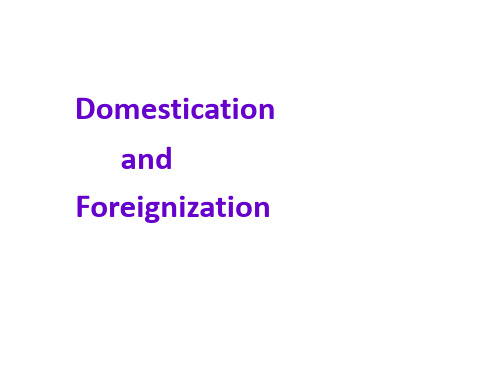
• • • • • • •
禁果 炮火的 洗礼 旧瓶装新酒 王牌 黑名单 条条大路通罗马 罗马不是一天建 成的。
• Chrysler were working feverishly to bring out their subcompacts(小型汽车). But the head of the Ford Motor Company had stuck his head in the sand. • 克莱斯勒公司正在全力以赴推出它们的超 小型汽车,而福特公司的总裁却把头埋在 沙堆里。
• My maternal grandfather, it is ture, was cut off in the flower of his youth at the age of sixty-seven, but my other three grandparents all lived to be over eigthty. 不错,我的外祖父英年早逝,当时只有67岁, 但是________________可都活到了80开外。 • key: 我的祖父、祖母和外祖母
Domestication
• 归化就是 “采取民族中心主义的态度,使 外语文本符合译入语的文化价值,把原作 者带入译入语文化” • --孙致礼《新编英汉翻译教程》P33 • 在翻译过程中把原文文化特色尽量转换到 译入语的语言和文化中去。所谓“转换” 就是原文的诸多表达手段向译入语文化靠 拢乃至融为一体。 • --张震久,2009,P118
• • • •
have a wolf by the ears to be out at elbows at one's wits' end seek a hare in a hen's nest • diamond cut diamond
翻译的归化和异化理论

Foreignization is a source-culture-oriented translation which strives to preserve the foreign flavor as much as possible in order to transfer the source language and culture into the target one.
定义Definition
归化(domestication)是指在翻译中采用透明、流畅的风格,最 大限度地淡化原文的陌生感的翻译策略。它应尽可能的使源语文本 所反映的世界接近目的语文化读者的世界,从而达到源语文化与目 的语文化之间的“文化对等”。
归化法是以目的语文化为归宿的翻译方法, 是基于人类文化和语言 的个性而发展。要求译者向译语读者靠拢,采取译语读者习惯的译 语表达方式,来传达原文的内容;
例子
① 异化可以在语音层上出现。例如: ballet译作“芭蕾舞” cigar译作“雪茄” laser过去译成“莱塞”,现译作“镭射”、“激光” 目前大街小巷都风行的“卡拉 OK”等。
② 异化可以在词语层出现。例如: “crocodile tears”译作“鳄鱼的眼泪” “an olive branch”译作“橄榄枝” “sour grapes”译作“酸葡萄” “the cold war”译作“冷战ove my dog. 爱屋及乌。 2.a lion in the way 拦路虎 3.lick one’s boots 拍马屁 4.Diamond cuts diamond 棋逢对手 5.A flash in a pan 昙花一现 6.Have one foot in the grave 风烛残年 7.To grow like mushrooms 雨后春笋 8.One boy is a boy,two boys half a boy,three boys nobody.一个和尚
归化异化概述及其运用
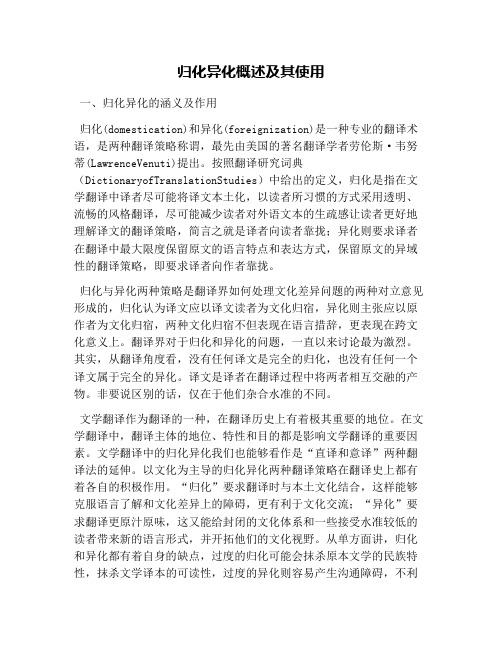
归化异化概述及其使用一、归化异化的涵义及作用归化(domestication)和异化(foreignization)是一种专业的翻译术语,是两种翻译策略称谓,最先由美国的著名翻译学者劳伦斯·韦努蒂(LawrenceVenuti)提出。
按照翻译研究词典(DictionaryofTranslationStudies)中给出的定义,归化是指在文学翻译中译者尽可能将译文本土化,以读者所习惯的方式采用透明、流畅的风格翻译,尽可能减少读者对外语文本的生疏感让读者更好地理解译文的翻译策略,简言之就是译者向读者靠拢;异化则要求译者在翻译中最大限度保留原文的语言特点和表达方式,保留原文的异域性的翻译策略,即要求译者向作者靠拢。
归化与异化两种策略是翻译界如何处理文化差异问题的两种对立意见形成的,归化认为译文应以译文读者为文化归宿,异化则主张应以原作者为文化归宿,两种文化归宿不但表现在语言措辞,更表现在跨文化意义上。
翻译界对于归化和异化的问题,一直以来讨论最为激烈。
其实,从翻译角度看,没有任何译文是完全的归化,也没有任何一个译文属于完全的异化。
译文是译者在翻译过程中将两者相互交融的产物。
非要说区别的话,仅在于他们杂合水准的不同。
文学翻译作为翻译的一种,在翻译历史上有着极其重要的地位。
在文学翻译中,翻译主体的地位、特性和目的都是影响文学翻译的重要因素。
文学翻译中的归化异化我们也能够看作是“直译和意译”两种翻译法的延伸。
以文化为主导的归化异化两种翻译策略在翻译史上都有着各自的积极作用。
“归化”要求翻译时与本土文化结合,这样能够克服语言了解和文化差异上的障碍,更有利于文化交流;“异化”要求翻译更原汁原味,这又能给封闭的文化体系和一些接受水准较低的读者带来新的语言形式,并开拓他们的文化视野。
从单方面讲,归化和异化都有着自身的缺点,过度的归化可能会抹杀原本文学的民族特性,抹杀文学译本的可读性,过度的异化则容易产生沟通障碍,不利于读者理解了解以及对整个篇章的把握。
归化与异化
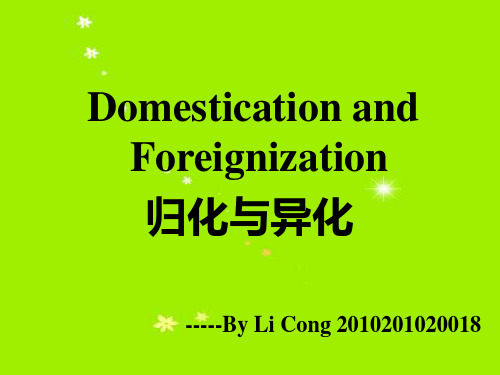
Some foreignization instances:
• 森格: 如果巴特尔救不活,我再回来收拾你。 Sen’ge: If Bater doesn’t live, I’m coming back to fix you up. • 图雅:把死当成个本事了是不是?要死我早死了。 还轮的上你来抢这个头功! Tuya: You think dying is some great skill, is that it? If I could I’d have already done it. But now you want to snatch the prize!
余曰‚卿果中道相舍, 断无再续之理。况‘曾经 沧海难为水, 除却巫山不是云’耳‛!
“Even if you should leave me half - way like this,” I said, “I shall never marry again. Besides, it is difficult to be water for one who has seen the great seas, and difficult to be clouds for one who has seen the Yangtze Gorges.” (foreignization)
Film Subtitle Translation
The characteristics of film subtitle translation :
comprehensive instantaneous oral
The choice of tanslation strategies in film subtitle translation:
For commercial and other considerations, domestication is more chosen in the English translation of Chinese film subtitles.
“归化”与“异化”-2019年文档
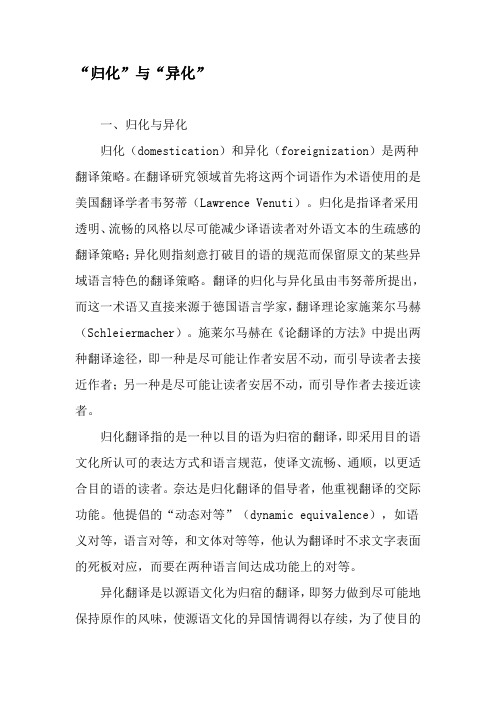
“归化”与“异化”一、归化与异化归化(domestication)和异化(foreignization)是两种翻译策略。
在翻译研究领域首先将这两个词语作为术语使用的是美国翻译学者韦努蒂(Lawrence Venuti)。
归化是指译者采用透明、流畅的风格以尽可能减少译语读者对外语文本的生疏感的翻译策略;异化则指刻意打破目的语的规范而保留原文的某些异域语言特色的翻译策略。
翻译的归化与异化虽由韦努蒂所提出,而这一术语又直接来源于德国语言学家,翻译理论家施莱尔马赫(Schleiermacher)。
施莱尔马赫在《论翻译的方法》中提出两种翻译途径,即一种是尽可能让作者安居不动,而引导读者去接近作者;另一种是尽可能让读者安居不动,而引导作者去接近读者。
归化翻译指的是一种以目的语为归宿的翻译,即采用目的语文化所认可的表达方式和语言规范,使译文流畅、通顺,以更适合目的语的读者。
奈达是归化翻译的倡导者,他重视翻译的交际功能。
他提倡的“动态对等”(dynamic equivalence),如语义对等,语言对等,和文体对等等,他认为翻译时不求文字表面的死板对应,而要在两种语言间达成功能上的对等。
异化翻译是以源语文化为归宿的翻译,即努力做到尽可能地保持原作的风味,使源语文化的异国情调得以存续,为了使目的语读者能够领略到“原汁原味”而不惜采用不符合目的语的语言规范。
韦努蒂是美国一位解构主义翻译思想积极创导者,他通过对西方翻译史的研究,批判了以往翻译中占主导地位的以目的语为归宿的倾向,并提出了以解构主义思想来反对译文通顺烦人翻译策略。
解构主义的翻译思想,不是要“求同”,而是要“存异”。
二、两译文的比较杨宪益与夫人戴乃迭合译的A Dream of Red Mansions和戴维•霍克斯翻译的The Story of the Stone,是《红楼梦》两个完整的英译本,二者都是公认的成功之作,且各有特色。
下面将以《红楼梦》第三回为例,从语言转化,诗词的翻译,以及文化输出等方面对两译文进行比较。
英汉翻译的方法——直译意译与归化异化

英汉翻译的方法——直译、意译与归化、异化一.直译与意译:在谈到直译和意译时,人们常常用英文词语literal translation 和freetranslation。
此时人们关心的是语言层面的技术处理问题,即如何在保持原语形式的同时,不让其意义失真;而意译则认为语言有不同的文化内涵和表达形式,当形式成为翻译的障碍时,就要采取意译。
直译和意译之争的靶心是意义和形式的得失问题。
在中国的翻译史上,赞成直译和意译的均有人在,初期佛典翻译中的文质说,唐代玄奘的“求真”与“喻俗”,近代有严复的“信达雅”及鲁迅的“宁信而不顺”与赵景深的“宁顺而不信”等,都是从直译和意译的角度来探讨翻译的原则。
1.直译(literal translation)英、汉语的结构有相同的一面,汉译时可照译,即直译。
直译既忠实原文内容,又符合原文的结构形式。
直译有不少优点,例如能传达原文意义,体现原文风格等。
但是,直译具有一定的局限性。
例如译文有时冗长罗唆,晦涩难懂,有时不能正确传达原文意义,有时甚至事与愿违。
Literal translation is where the forms of the original are retained as much as possible, even if those forms are not the most natural forms to preserve the original meaning.Literal translation is sometimes called word-for-word translation (as opposed to thought-for-thought translation). A more accurate, but less well-known, label for this approach is formal equivalence translation. Because literal translation focuses on forms of language, it sometimes misses some of the meaning of those forms, since meaning is found not only in the forms of individual words, but also in relationships among words, phrases, idiomatic uses of words, and influences of speaker-hearer, cultural, and historical contexts. Words often have different meanings in different contexts, but a literal translation often does not account for these differences. So literal translation often is not the most accurate form of translation.直译的五大误区:①否定句型中的直译误区英语中有一些不同的否定句型,其中有一些句型不能完全采用直译法进行翻译,否则,就会造成误译,甚至与原意背道而驰,下列几种否定句型值得注意:A.部分否定句型,这种句型不同于汉语的思维形式。
归化和异化翻译理论论文(英语版)
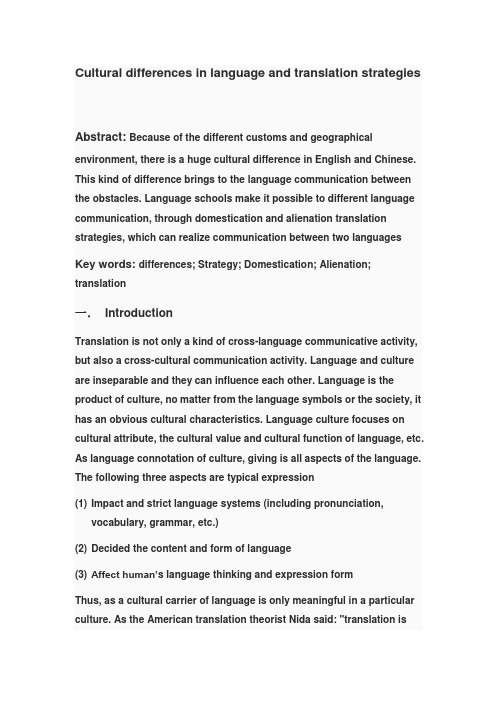
Cultural differences in language and translation strategiesAbstract:Because of the different customs and geographical environment, there is a huge cultural difference in English and Chinese. This kind of difference brings to the language communication between the obstacles. Language schools make it possible to different language communication, through domestication and alienation translation strategies, which can realize communication between two languagesKey words: differences; Strategy; Domestication; Alienation; translation一.IntroductionTranslation is not only a kind of cross-language communicative activity, but also a cross-cultural communication activity. Language and culture are inseparable and they can influence each other. Language is the product of culture, no matter from the language symbols or the society, it has an obvious cultural characteristics. Language culture focuses on cultural attribute, the cultural value and cultural function of language, etc. As language connotation of culture, giving is all aspects of the language. The following three aspects are typical expression(1) Impact and strict language systems (including pronunciation,vocabulary, grammar, etc.)(2) Decided the content and form of language(3) Affect human’s language thinking and expression formThus, as a cultural carrier of language is only meaningful in a particular culture. As the American translation theorist Nida said: "translation isthe communication between the two cultures. For truly successful translating, familiar with two cultures is even more important than to master two languages.” there is a huge difference in Chinese-English nationality values, beliefs, customs, historical background, geographical conditions, social system, life experience, etc. This difference not only imprint their respective language but also bring many difficulties for the mutual translation between the two languages. This article start from the cultural differences of Chinese-English, try to seek the cultural equivalence translation by domestication and alienation.二.cultural differences between Chinese-EnglishBecause language is a product of culture and the social, we should understand it from the perspective of cultural and social. Chinese culture emphasize the "value theory" while English advocating "personal value supremacy". Besides values differences, Chinese-English cultural differences there are geographical environment and social environment, climate conditions and customs, etc.(一) cultural differences caused by geographicalenvironmentThere is a regional culture. Special geographical environment and climate characteristics of the skin often give the region culture. Britain is the island, located in the western hemisphere, north temperate zone, oceanic climate, so its language reflect the geographical characteristics. For example: spend money like water; make water; all at sea. While China is located in mainland Asia, Chinese say “spend money like earth”As for the different climate lead to the different culture is also numerous. For example “Dongfeng” in China is the symbol of harvest, while “West Wind” replaces it in west countries.(二) cultural differences caused by CustomsChinese-English cultural differences caused by customs is obvious on animal vocabulary. British culture is the typical "Ma Wenhua", such as talk horse, get on one’s high horse,horse and horse etc. However, Chinese a "NiuWenHua".三.Translation and StrategiesDomestication and alienation into China, many researchers raised their opinions on the two translation strategies. In 1987, an academic paper entitled “Domestication: The Wrong Track in Translation” by Liu Yingkai aroused the first round of dispute on domestication and alienation. In 1995, Weihui Reading Weekly and Foreign Languages School of Nanjing University organized a survey of readers, responses to different versions of the French novel Scarlet and Black, which gave rise to a debate on many translation issues, including domestication and alienation . Domestication and alienation serve as two major translation strategies. The two terms originated from German theologician and philosopher, Friedrich Schleiermacher’s lecture. Later on, Venuti (1995) explained the two terms. According to Venuti, domestication is the dominating translation strategy in Anglo-American culture. Employment of domestication brings the original text and author to the target text readers, erasing the linguistic and cultural differences and making the original text conform to the current dominant linguistic characteristics and values in the target-language culture. Alienation was coined by Venuti to resist domestication. Application of alienation brings the target language readers to the original author and the original text, keeping the original linguistic and cultural differences and even attempting to find differences. We may realize alienation by using non-standarddiscourse or choosing to translate a text that challenges the contemporary canon.Reference:[1]Nida, Eugene A. Language, Culture and Translating. Shanghai Foreign Language Education Press. 1993:105-115.[2]赵爱国.语言文化学论纲[M].黑龙江人民出版社,2006:28-41.屈小楠,李春晓,冉小桃,徐相舒。
02翻译的归化和异化.

异化翻译与归化翻译异化翻译法(或异化法) (foreignizing translation or minoritizing translation) 和归化翻译法(或归化法) ( domesticating translation or domestication) 是美国翻译理论家Lawrence Venuti (1995)创造出来用来描述翻译策略的两个术语。
异化翻译法是故意使译文冲破目的语的常规,保留原文中的异国情调。
Venuti 把异化翻译法归因于19 世纪德国哲学家Schleiermacher 的翻译论说“译者尽量不惊动原作者,让读者向他靠近”( Schleiermacher , 1838P1963 : 47 , 1838P1977 : 74 ;V enuti ,1995 :19) 。
Schleiermacher 本人是赞同采用异化法的。
Venuti (1995 :20) 指出,在盲目自大地使用单语并把归化翻译法作为标准的文化社会(例如英美社会) 中应提倡异化翻译法。
在这种情况下采用异化法是一种对当时的社会状况进行文化干预的策略,因为这是对主导文化心理的一种挑战。
主导文化心理总是尽力压制译文中的异国情调(或“异物”) 。
Venuti 把异化翻译描述成一种“背离民族的压力”(1995 :20) ,其作用是“把外国文本中的语言文化差异注入目的语之中,把读者送到国外去”(1995 :20) 。
具体来说,异化翻译法包括以下特点: (1)不完全遵循目的语语言与语篇规范; (2) 在适当的时候选择不通顺、艰涩难懂的文体; (3) 有意保留源语中的实观材料或采用目的语中的古词语; (4) 目的是为目的语读者提供一次“前所未有的阅读经验”(1995 : 20) 。
不过,Venuti 也承认,译文是由“本土的文化材料”组成的,异化翻译(像归化翻译那样) 只能是翻译过程中的一种策略,所不同的是,采用异化法的译者一般都态度鲜明,而不是隐隐匿匿(1995 :34) 。
5.异化和归化

异化和归化翻译技巧杂谈(二) [On Skills of Translation (Ⅱ)]异化和归化(Foreignizing, Alienation and Domesticating, Adaptation)异化是要保存源语的异国情调,就是要有“洋味”;归化则是要把源语本土化,在我国也称汉化(sinicization),用本语言文化中的习惯表达方式来转换源语。
如:go with the stream随波逐流(归化译法);随溪逐流(异化译法)draw water in sieve竹篮打水(归化译法);以筛取水(异化译法)a drawn rat落汤鸡(归化译法);落汤鼠(异化译法)归化是用源语词语有相同使用频度,又带有某些译文色彩的词语来翻译源语文字。
归化的长处在于使译文读来比较地道和生动。
11.1.1翻译成语与典故时常采用归化方法,以求保持它们特有的简洁性和精炼的表现力一箭之遥at a stone's throw挂羊头卖狗肉cry wine and sell vinegar The sign says mutton,but only dogmeat for sale.过牛马不如的生活to live a dog's life缘木求鱼to seek a hare in a hen's nest山中无老虎,猴子称大王。
Among the blind the one-eyed man is king.骑墙to sit on the fence躺在自己的功劳簿上to rest on one's laurels鹤立鸡群stand out like a peacock in a barnyard11.1.2表形状字母的归化翻译英语中有些名词是用一个表形状的字母开头的,如果汉语中有表示这种形状或近似这种形状的译词的话,常用表意的归化方法来译,如:U-steel槽钢T-square丁字尺Z-shaped之字形I-bar工字钢V-neck鸡心领an inverted V八字形Y-intersection三叉路口U-shaped magnet马蹄形磁铁但是,大多数时候,由于不能在汉语中找到相应的译词,我们只好采用表形法(formal translation),即把原词中表形的字母借过来,然后将该字母后面的词意译,并在两者之间用“形”字连接,从而得一完整的表形状的译文,如:S-hook S形钩H-post H形电杆U-bend u形急弯T-plate丁字板U-tube U形试管A-frame A形架B-V-shaped V形C-C-washer C形垫圈11.1.3 异化与归化从译文读者角度来看,归化成分的文化色彩一般应该较被归化成分的文化色彩为弱。
归化和异化的总结

归化和异化的总结引言归化(Domestication)和异化(Foreignization)是翻译学中两个重要概念。
归化指的是在翻译过程中,根据目标语言的习惯和规范,将源语言的文本转化为目标语言的一种处理方式。
而异化则是尽可能地保留源语言的特点和风格,使翻译结果有源语言的味道。
本文将对归化和异化的概念及其在翻译实践中的运用进行总结和分析。
归化的特点和运用归化是指将源语言的文本转化为符合目标语言的语法、习惯和风格的处理方式。
归化的特点主要有以下几点:1.符合目标语言习惯:归化使得翻译结果更符合目标语言读者的阅读习惯和语言规范。
例如,将源语言的日期格式转化为目标语言的日期格式。
2.易于理解:归化使得翻译结果更易于读者理解和接受。
通过使用目标语言的常用词汇和习语,减少读者对于陌生词汇和文化背景的理解障碍。
3.兼顾文化差异:归化可以在尊重源语言文化的基础上,融入目标语言的文化特点。
通过调整表达方式和文化隐喻,使翻译结果更具有地域特色。
在翻译实践中,归化可以用于各种类型的翻译任务。
特别是在商务文件、科技文献等领域,为了确保准确传达源语言的信息,归化是一种常用的处理方式。
异化的特点和运用异化是指尽可能地保留源语言的特点和风格,使翻译结果有源语言的味道。
与归化相反,异化更注重保留源语言的原汁原味。
异化的特点主要有以下几点:1.保留源语言风格:异化允许源语言的特有风格和表达方式在翻译过程中得以保留,使目标语言读者能够感受到源语言的文化和语言氛围。
2.文化传递:异化可以在一定程度上传递源语言的文化信息和情感。
通过保留源语言的文化隐喻、习语和修辞手法,使得翻译结果贴近源语言的文化背景。
3.翻译的创造性:异化要求译者具备一定的创造性思维,使得翻译结果更具有艺术性和独特性。
通过运用诗歌形式、修辞手法等,使翻译结果更符合源语言原文的表达方式。
在文学翻译领域,异化被广泛运用。
通过保留源语言原文的特点和风格,使译文更具有文学价值和审美效果。
- 1、下载文档前请自行甄别文档内容的完整性,平台不提供额外的编辑、内容补充、找答案等附加服务。
- 2、"仅部分预览"的文档,不可在线预览部分如存在完整性等问题,可反馈申请退款(可完整预览的文档不适用该条件!)。
- 3、如文档侵犯您的权益,请联系客服反馈,我们会尽快为您处理(人工客服工作时间:9:00-18:30)。
下面请看一些例子:
一、英语中的一些表达方法在汉语中有相应的对应体:
1、 as timid as a hare 胆小如鼠
2、To strike while the iron is hot
趁热打铁
3、Money is the root of all evil
金钱是万恶之源
4、lucky dog
幸运儿
二、相应的汉语中的许多表达方法,在英语中也可以找到相应 的对应体:
笑掉大牙(形义不对应)
4、 In the county of the blind the one -eyed man is king. 盲人国内, 独眼为王
5、dark horse
黑马
二、相应的一些汉语中的一些表达方法,通过异化在英语中也 有相应的对应体:
1ct ivory from a dog ’ s mouth.
6、 《Midnight Cowboy》——《午夜牛郎》(异化与归化同 时使用)
制作人:
所谓归化,就是译者在翻译时在尽可能的把原文的内容和风 格准确而生动的表达出来的同时,还要想着译文的读者,使翻译 出来的东西尽可能接近读者,便于读者理解和接受。即德国学者 施莱尔马赫(Schleiermacher)在论文《论翻译的不同方法》提到的 翻译的一种情况:“尽量不打扰原作者而将读者移近作者。” 归化的产生是由于世界各国虽然地理位置不同,但也有许 多相似的文化,即文化的共性;而文化的共性反映在语言之上, 即语义的对应。
一、英语中的一些表达方式通过异化得到汉语相应的对应:
1、eat like a horse 狼吞虎咽(形义不对应)
2、 All the rivers run into the sea,yet the sea is not full。 百川归海,而海不盈(形义对应)
3、 to laugh off one’s head
1、 《The Bathing Beauty》——《出水芙蓉》(采用中国习语典故或民众 流行语) 2、 《The Reader》——《生死朗读》(片名过短,为达其艺术价值) 3、 《One Flew over the Cuckoo’s Nest》——《飞越疯人院》(文化差异 而不通顺 “飞越杜鹃窝”) 4、 《The Da Vinci Code》——《达芬奇密码》(人名、地名、历史事件 等) 5、 《Dances With The Wolves》——《与狼共舞》(片名可直接反映电内 容)
1、找麻烦 look for trouble
2、雨后春笋
like mushroom(蘑菇)
3、穷得像叫花子
as poor as church mouse
4、宾至如归
Guests feel at home
所谓异化,就是译者在接受外语文本的语言及文化差异 的情况下,把读者带入外国情境。其核心就是尽量传译原文 的“异质因素”,具体说来,就是要尽量传达原作的异域文 化特色,异语语言形式,以及作者的异常写作手法。即德国 学者施莱尔马赫(Schleiermacher)在论文《论翻译的不同方法》 提到的翻译的一种情况:“尽量不打扰读者而将作者移近读 者。” 异化的产生是由于各国的文化又有一定的差异性,每 个国家的文化都有其独有的文化特色,所以就要求在翻译时 要尽量保留外国文化的气质。
2、旧瓶装新酒
New wine in old bottles
3、君子协定
gentleman’s agreement
4、门户开放政策
the open door policy
1、She could not desert Tara; she belonged to the red acres far more than they could ever belong to her.(M. Mitchell: Gone with the Wind, p. 20)
